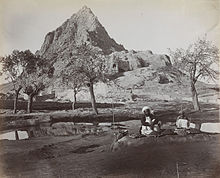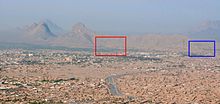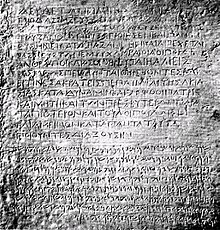Chil Zena
 | |
| Coordinates | 31°36′55″N 65°39′49″E / 31.61528°N 65.66361°E |
|---|---|
| Type | Mountainous outcrop |


Chil Zena ("Forty steps"), also Chilzina or Chehel Zina, is a mountainous outcrop at the western limit of the city of
Persia in 1738.[2] The carving of the staircase was commissioned by the Emperor Babur.[3] Chil Zena later received numerous inscriptions about the conquests of Babur (1526-1530), apparently carved by his son Humayun.[1]
Chil Zena is well known for the discovery of the Indian Emperor Ashoka's Kandahar Bilingual Rock Inscription on the mountainside, which is still located on in an open-air compound on the mountainside.[1] The presence of this inscription at Chil Zena helped confirm the presence of Greek populations in the vicinity in the 3rd century BCE, as well as the extent of Ashoka's control, which is therefore thought to have incorporated Kandahar and its region of Arachosia.[1]
References
- ^ ISBN 9781400858910. Retrieved 2016-11-27.
- ^ British Library Online
- ^ "Chilzina and the Forty Steps of Kandahar".

